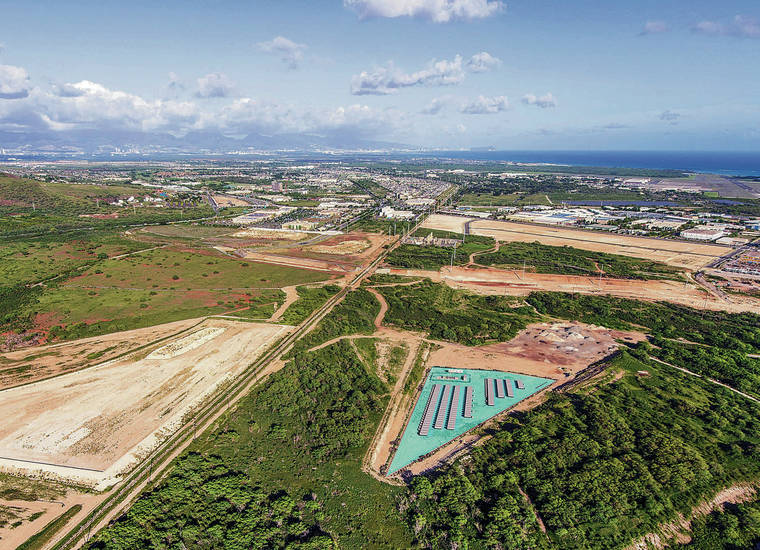Public Utilities Commission agrees to modify conditions for Hawaiian Electric’s battery storage project

COURTESY PLUS POWER
An aerial rendering of Plus Power’s proposed Kapolei Energy Storage project on Oahu.
The state Public Utilities Commission has granted and modified a set of conditions Hawaiian Electric objected to last week in order to move forward on a major battery storage project in Kapolei.
On Thursday, the PUC responded to the utility’s objections to the conditions — four in particular — attached to its approval of the high-profile Kapolei Energy Storage project which is expected to bridge the energy gap when Oahu’s 180-megawatt coal plant retires next fall.
The PUC said its decision and the conditions were not intended to be punitive or derogatory to Hawaiian Electric.
“On the contrary, the Commission did not approach its decision from the perspective of the potential consequences that may come to bear on Hawaiian Electric,” said the PUC, “but rather focused on ensuring the most beneficial utilization of the Project and supporting the maximization of benefits delivered to ratepayers from a project expected to cost over $500 million.”
Hawaiian Electric said it is reviewing the PUC’s ruling on the proposed Kapolei project.
“It appears the commission’s order addresses most of Hawaiian Electric’s concerns regarding conditions imposed by the PUC,” said the utility in a statement. “Hawaiian Electric appreciates the commission’s prompt response and its flexibility as we both work to deliver the best possible outcome for customers.”
Don't miss out on what's happening!
Stay in touch with breaking news, as it happens, conveniently in your email inbox. It's FREE!
The PUC on April 29 attached nine conditions to its approval of the Kapolei project.
Hawaiian Electric on Monday objected to six out of the nine Opens in a new tabconditions Opens in a new tab, which it asked the PUC to reconsider, but identified the following four, in particular, as highly problematic Opens in a new tab:
>> Condition No. 1: Requiring Hawaiian Electric to forego up to $1.7 million performance-based rewards from “stage 1” renewable energy projects, which the Kapolei Energy Storage is not a part of.
>> Condition No. 2: Requiring Hawaiian Electric to ease grid constraints to allow more community-based renewable energy and private solar rooftop projects to go online.
>> Condition No. 3: Requiring Hawaiian Electric to financially retire another six fossil-fuel units at Waiau and Kahe as planned in stages from 2023 to 2028 without delays or foot the potentially higher costs instead of consumers.
>> Condition No. 5: Establishing minimum thresholds of renewable energy to charge the battery project and a “prudence review” of fossil fuel costs if they are not met.
Hawaiian Electric said physical upgrades are necessary to ease grid restraints and accommodate new sources of renewable energy. Also, that meeting minimum thresholds of renewables to charge the battery project as specified was not realistic, and that it would limit charging times and diminish its economic benefits for customers.
The utility said, for example, it would not be able to meet minimum thresholds of 75% renewables for the project’s second to fifth year for more than a decade. Based on a new analysis, however, it estimated the battery project would be charged by 63% renewables on average over its 20-year lifetime.
The PUC agreed that conditions Nos. 1 and 2 could be addressed in separate dockets. It agreed to modify conditions No. 3 and 5 by removing specific dates from the former, and removing specific thresholds and timelines for the latter. Instead, the commission said it will automatically conduct a “prudence review” on an annual basis for the first 10 years of the project.
It also modified some of the specifics in reporting requirements showing how much of the energy stored and dispatched by the battery project would come from renewable versus fossil fuel sources.
The PUC, however, declined to strike certain phrases from its April 29 decision, such as “appalling failures” to consider alternatives to the battery project, “willful disregard” of the commission’s guidance, and “negligence” in preparing for the retirement of the AES Hawaii coal plant.
“The Commission’s intent was not to impugn Hawaiian Electric’s integrity, but instead to highlight the seriousness of the situation and the Commission’s focus on its duties and obligations to the public,” said the PUC. “The Commission is responsible for ensuring consumers are provided essential utility services in a safe, reliable, economical, and environmentally sound manner. Indeed, the Commission is deeply committed to fulfilling its obligations and, in so doing, imposed reasonable Conditions and used pointed language in describing its disappointment with being placed in the position of having few options to respond to the extremely serious situation that is developing as a result of the retirement of the AES coal plant next year.”
San Francisco-based developer Plus Power describes Kapolei Energy Storage as a state-of-the-art battery energy storage system that will connect to a critical Hawaiian Electric substation to provide fast-frequency response services, improving grid reliability.
With 185 megawatts of power and 565 MW-hours of battery energy storage, it would be the largest stand-alone battery storage system in the state upon its projected completion in the summer of 2022.



